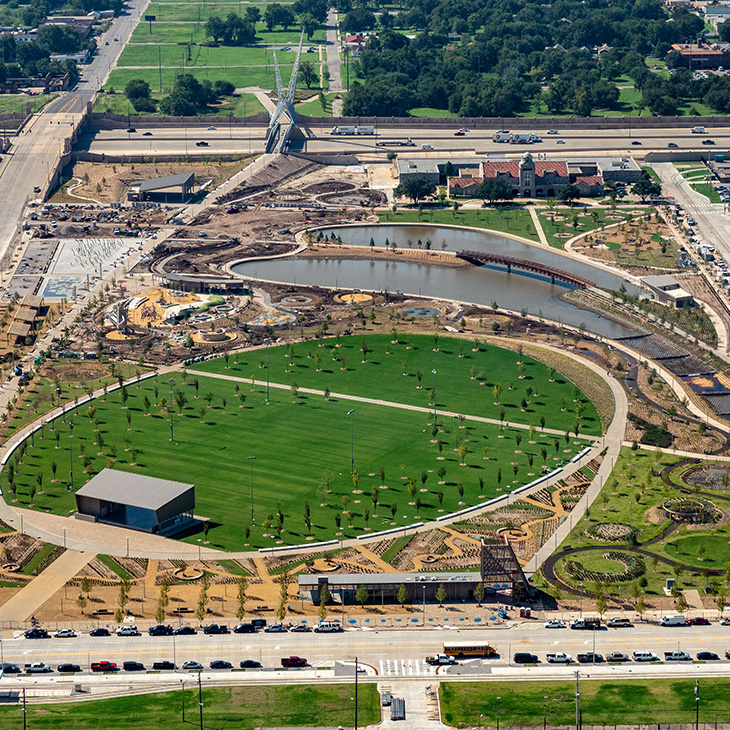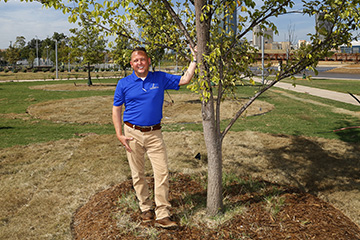
OKC park green to go with Extension resources
Tuesday, April 21, 2020
OKLAHOMA CITY – The flowers, trees and other flora now in spring bloom at Scissortail Park are perfect for central Oklahoma’s environment, Lance Swearengen said.
That’s not hyperbole, either; it’s a design point expected to save hundreds of thousands of dollars for taxpayers who backed the MAPS 3 project, the park’s director of horticulture said recently.
“We planted 40,000 daffodils in preparation for the first festival before the pandemic changed schedules for big events,” Swearengen said as he waved his hand across a swath of bright yellow. “This whole hillside in another week will be amazing because these plants are naturalized for Oklahoma. They really fit our native palette well.”
The park was one of several signature developments under Metropolitan Area Projects, or MAPS 3, the third in a series of penny sales tax issues approved by Oklahoma City voters. The full MAPS 3 package was projected to collect a total of $777 million to develop a downtown streetcar, a new convention center, a massive central park and several other projects. Of that figure, Scissortail Park was budgeted at $132 million.
For that cost, taxpayers are expecting not just a beautiful, comfortable, tourist attraction and gathering place for metro residents, but features that will last years without increasing investment, Swearengen said. In other words: Avoid installing plants that die and have to be replaced.
A lot of decisions already had been made before the Oklahoma State University alumnus came to work at the park. A couple of years ago he was horticulture curator at the Oklahoma City Zoo. Swearengen earned both his master’s degree in horticulture science and his bachelor’s degree in public horticulture and public garden management from OSU.
For example, an intricate network of French drains circulates surface water back to the park pond, where it filters through several terraces of water plants. Many of the trees chosen for the park are appropriate to the Cross Timbers environment, an ecological region of woody vegetation across Oklahoma, Kansas and Texas. The most important Cross Timbers species are post oak and blackjack, which are slow-growing and shade-intolerant.
Swearengen credited OSU Extension staff who he regularly contacts in metro Oklahoma
City for providing much of the latest science-based materials used in Scissortail’s
design.
Courtney DeKalb-Myers, a horticulture educator at the Cleveland County OSU Extension office, said she’s looking forward to visiting Scissortail and seeing some of the conservation facets in play. DeKalb-Myers attended OSU with Swearengen.
“Other people can do the same thing,” she said. “We’ve got a lot of fact sheets that list really good choices for specific uses, like if you’re looking for shady plants or a specific type of flower. Our resources on xeriscaping – low-water use – are excellent for Oklahoma’s dry weather months. If plants aren’t adapted, they’ll require a lot of costly maintenance or you might lose them.”
Scissortail Park’s design and horticultural management are in line with the environmental protection and conservation philosophy of Earth Day, which will celebrate its 50th anniversary worldwide on April 22.
The Farmers Market at OSU’s Oklahoma City campus also will merge with Scissortail Park this year to give the market more space in the heart of downtown. More than 80 vendors expressed interest before April.
However, park officials said they will wait to formally open events on park grounds until after shelter-in-place orders are lifted by government officials.
The north 40 acres of Scissortail are ready for the public; the remaining 30 acres on the south side of Interstate 40 are scheduled to be completed in 2021.
More information about the park, including public access policies regarding COVID-19, is available online.
Horticulture fact sheets and related materials can be found at OSU Extension’s website.
MEDIA CONTACT: Brian Brus | Agricultural Communications Services | 405-744-6792 | BBrus@okstate.edu

